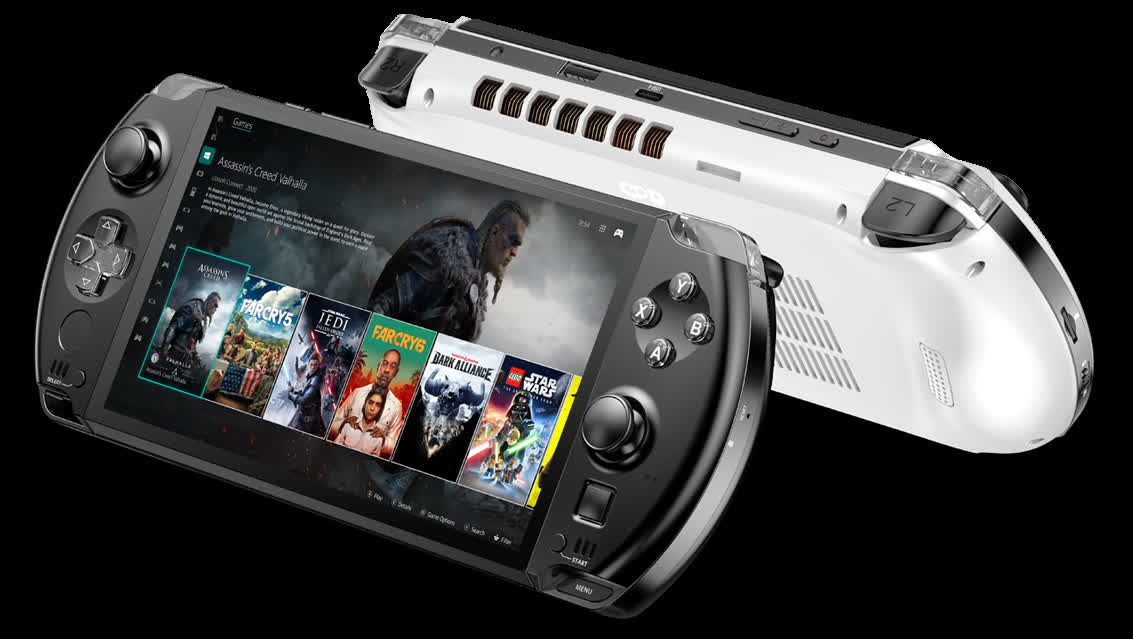Something to look forward to: The Asus ROG Ally aimed to intensify the handheld gaming PC wars when it challenged the Ayaneo 2 and GPD Win 4 using AMD's latest architecture. Now GPD has responded with a quick refresh that upgrades to the same architecture but changes little else.

Handheld PC maker GPD recently unveiled two new models of the GPD Win 4. Arriving in August – just five months after the original variant's March debut – the new units feature specs undoubtedly meant to challenge the Asus ROG Ally, which launched in May. The company has yet to reveal price points.
At first glance, the GPD Win 4 7840U and 7640U could easily be mistaken for their predecessor, retaining their name and PSP-inspired chassis. Other than the processor and graphics upgrades, the only significant additions are options for 64GB of RAM and 4TB of onboard storage. Comparing the enhancements to the ROG Ally makes the reason for the refresh obvious.
| GPD Win 4 7840U | GPD Win 4 7640U | GPD Win 4 6800U | ROG Ally Z1 Extreme | ROG Ally Z1 | Steam Deck | |
|---|---|---|---|---|---|---|
| CPU Architecture | Zen 4 | Zen 4 | Zen 3+ | Zen 4 | Zen 4 | Zen 2 |
| Cores | 8C/16T | 6C/12T | 8C/16T | 8C/16T | 6C/12T | 4C/8T |
| Max Boost Clock | 5.1GHz | 4.9GHz | 4.7GHz | 5.1GHz | 4.9GHz | 3.5GHz |
| GPU | RDNA 3 (12CUs) | RDNA 3 (8CUs) | RDNA 2 (12CUs) | RDNA 3 (12CUs) | RDNA 3 (6CUs) | RDNA 2 (8CUs) |
| GPU Frequency | 2.7GHz | 2.6GHz | 2.2GHz | Up to 2.7GHz | Up to 2.5GHz | 1.0-1.6GHz |
| RAM |
64GB 32GB |
16GB |
32GB 16GB |
16GB | 16GB | 16GB |
|
Onboard Storage Capacity |
512GB 2TB 4TB |
512GB | 1TB/2TB | 512GB | 256GB |
64GB 256GB 512GB |
| Display | 1080p 60hz H-IPS |
1080p 60hz H-IPS |
1080p 60hz H-IPS | 1080p 120Hz VRR IPS |
1080p 120Hz VRR IPS |
800p 60Hz LCD |
| External Graphics | Oculink | Oculink | USB-C | XG Mobile |
XG Mobile |
Not Supported |
| Operating System |
Windows 11 SteamOS (optional) GPD OS (optional) |
Windows 11 SteamOS (optional) GPD OS (optional) |
Windows 11 SteamOS (optional) |
Windows 11 |
Windows 11 |
SteamOS Windows 11 (optional) |
| Battery | 45.62Wh | 45.62Wh | 45.62Wh | 40Whr | TBD | 40Whr |
| TDP | 15-30W | 15-30W | 28W | 9-30W | TBD | 4-14W |
| Price | TBD | TBD | $800-$1,200 |
$699 |
TBD | $399-$649 |
After Valve's Steam Deck swung the doors open for handheld gaming PCs, the Ayaneo 2 and subsequent GPD Win models tried to leapfrog its AMD Zen 2 RDNA 2 APU with the Zen 3+ Ryzen 7 6800U. However, Asus stormed in with its Zen 4 RDNA 3-based ROG Ally.
The GPD 4 revisions follow with processor and graphics specs that look almost identical to the Ally Z1 Extreme and the upcoming lower-end Z1. Both competitors' high-end models have 8-core 16-thread CPUs, which boost to 5.1GHz, paired with 12 RDNA 3 CUDA cores maxing out at 2.7GHz. The cheaper models on both sides are also close, with six cores and 12 threads at 4.9GHz, although the GPD Win 4 7640U's graphics might have a slight edge over the ROG Ally Z1 with two more CUDAs. However, GPD didn't mimic the ROG Ally's 120Hz VRR screen.
Although all the recent Steam Deck competitors appear far more potent than Valve's handheld, the company isn't concerned. Last year, Valve said it would prefer to focus more on battery life than horsepower. The Steam Deck tops out at half the wattage of the GPD and Asus machines. The Deck shouldn't see any significant upgrades anytime soon.
https://www.techspot.com/news/99237-gpd-win-4-receives-upgrade-zen-4-rdna.html